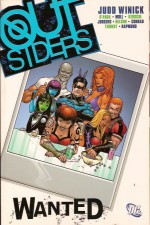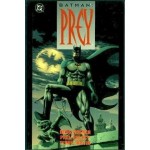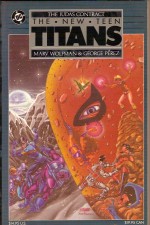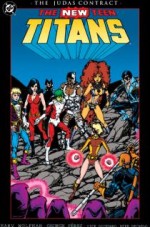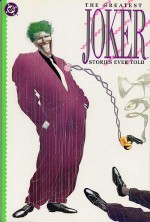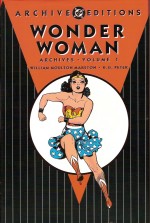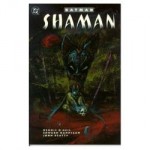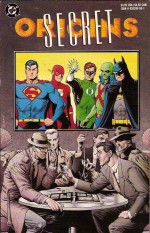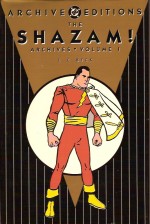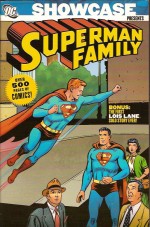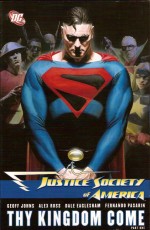
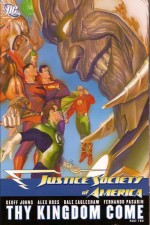
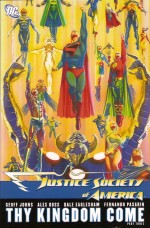
By Geoff Johns, Alex Ross, Dale Eaglesham, Fernando Pasarin & various (DC)
ISBNs: 978-1-4012-1741-9,  978-1-4012-1946-8,  978-1-4012-2167-6
After the actual invention of the comicbook superhero – for which read the launch of Superman in 1938 – the most significant event in the genre’s (and indeed industry’s) progress was the combination of individual stars into a group. Thus what seems blindingly obvious to us with the benefit of four-colour hindsight was proven – a number of popular characters could multiply readership by combining forces and fan-bases. Plus of course, a whole bunch of superheroes is a lot cooler than just one – or even one and a sidekick.
The Justice Society of America was created for the third issue (Winter 1940/1941) of All-Star Comics, an anthology title featuring established characters from various All-American Comics publications. The magic was instigated by the simple expedient of having the assorted heroes gather around a table and tell each other their latest adventure. From this low key collaboration it wasn’t long before the guys – and they were all white guys (except Red Tornado who merely pretended to be one) – regularly joined forces to defeat the greatest villains and social ills of their generation. Within months the concept had spread far and wide…
And so the Justice Society of America is rightly revered as a true landmark in the development of comicbooks. When Julius Schwartz revived the superhero genre in the late 1950s, the game-changing moment came with the inevitable teaming of the reconfigured mystery men into a Justice League of America.
From there it wasn’t long until the original and genuine article returned. Since then there have been many attempts to formally revive the team’s fortunes but it wasn’t until 1999, on the back of both the highly successful rebooting of the JLA by Grant Morrison & Howard Porter and the seminal but critically favoured new Starman series by Golden Age devotee James Robinson, that the multi-generational team found a new mission and fan-base big enough to support them. As the century ended the original super-team returned and have been with us in one form or another ever since.
This iteration, called to order after Infinite Crisis and Identity Crisis, found the surviving heroes from World War II acting as mentors and teachers for the latest generation of young champions and metahuman “legacy-heroes†(family successors or inheritors of departed champions’ powers or code-names): a large, cumbersome but nevertheless captivating assembly of raw talent, uneasy exuberance and weary hard-earned experience (for details see Justice Society of America: the Next Age and Justice League of America: The Lightning Saga).
This triptych of tomes collects issues #7-22 of the Justice Society of America series, the first Annual and Justice Society of America Kingdom Come Specials: Superman, Magog and The Kingdom; expanding, clarifying and building on those new heroes introduced in the landmark 1996 Mark Waid & Alex Ross miniseries, by rationalising many of the characters and concepts with the then-current DC continuity.
Kingdom Come and its belated sequel The Kingdom managed to connect that initially ring-fenced continuity to the mainstream DC universe and introduced “Hyper-Timeâ€, a bridging concept which opened the way for all the storylines and history eradicated in Crisis on Infinite Earths to once more be “real and trueâ€. Gradually a number of those variant elements began to coalesce in the relaunched Justice League and Justice Society series culminating in the expansive extended epic collected in these three volumes – although the entire saga could happily have fitted into one large tome…
This ambitious and almost daunting epic commences when Nathan Heywood awakes after an attack by modern Nazi meta-humans to realise most of his family have died in the assault. Of little comfort is the fact that his own crippling injuries have been repaired by the activation of his latent powers. The paraplegic youth has become a creature of living steel; unfeeling and ‘Indestructible’. For the sake of his surviving kin Heywood assumes the persona of new legacy hero Citizen Steel.
Soon after, ‘Bells and Whistles’ concentrates on the history of Jesse Chambers, wife of the second Hourman and daughter of WWII heroes Johnny Quick and Liberty Bell. Jesse inherited the powers of both parents but her level-headedness is all her own and vitally necessary when fellow member Damage, fuelled by berserker rage, breaks a State Exclusion Order whilst chasing super villain Zoom – the hyper-fast maniac who shredded the hero’s face and turned him into a hideous monster doomed to hide forever behind a mask.
‘Prologue: Thy Kingdom Come’ switches focus to Power Girl who has only recently discovered her true origins as a survivor from an alternate universe where her cousin Superman was the World’s Greatest Hero and leader of an another Justice Society, now all long-gone and forever lost in a universe-shredding Infinite Crisis…
During a gala party for three generations of heroes, the team are called to a flaming mystical conflagration and when 31st century refugee and barely-in control schizophrenic Starman uses his powers to extinguish the blaze he inadvertently plucks a survivor out of the void between dimensions.
This newcomer looks and sounds just like Power Girl’s own dearly-departed Earth-2 Superman…
‘What a Wonderful World’ sees the Man of Steel from the Kingdom Come continuity describe how the heroes and their successors of his world almost destroyed the planet (with flashback sequences painted by Alex Ross) before Starman explains his own connection to all the realms of the multiverse. Initially suspicious, the JLA come to accept the elder Man of Steel.
Elsewhere, a deadly predator begins to eradicate demi-gods and pretenders to divinity throughout the globe…
‘The Second Coming’ reveals how the Strange Visitor from Another Earth believes his world dead, just as a new crop of legacy heroes (Judomaster, Mr. America, Amazing Man, Lightning and David Reid) join the team, whilst in ‘New Recruits’ the death-toll of murdered godlings mounts rapidly…
This first volume concludes with an expansive sketch section from Alex Ross.
The second book of Thy Kingdom Come (collecting Justice Society of America #13-18 and Annual #1) opens with ‘Supermen’ wherein the latest incarnation of Mr. America (an FBI agent turned freelance super-villain profiler) alerts the JSA to the serial god-killer and points the way to a mysterious personage known only as Gog.
When his files reveal their suspect to be an old foe of this world’s Superman, his elder alternate volunteers to discuss the case with the Man of Steel whilst deep below the fertile earth of the Congo an alien presence communes with its apocalyptic herald…
‘Thy Kingdom Come: Gog’ at last begins the epic in earnest as the assembled team is attacked by the mysterious Gog, resulting in a staggering battle in ‘The Good Fight’ and culminating in a dramatic climax in Africa and the release and apotheosis of the One True Gog…
This immense being is an ancient deity from the race which spawned the New Gods and has been gestating in our Earth since his own world died uncounted millennia ago…
The colossal gleaming god immediately proclaims a new era for Mankind in ‘He Came, and Salvation With Him’: striding across Africa, ending want, cleansing the scorched earth, feeding the starving and curing the afflicted with broad waves of his gigantic hands.
The battle-hardened heroes are highly suspicious but since among those cured are Damage, Star Man, Doctor Midnite and Sand the miracles cause a split in the JSA ranks in ‘Wish Fulfillment’.
Something is not right though: beyond the haughty bombast there are inconsistencies. Atheist Mr. Terrific is apparently invisible to the wandering god and despite his hopes and prayers Citizen Steel is ignored whilst all others have their wishes granted even without asking.
For example Power Girl but not Superman are summarily dispatched “Homeâ€â€¦
With confrontation seemingly inevitable the beneficent Gog suddenly diverts from his path and declaims that he will eradicate all war…
‘Earth-2 chapter one: Golden Age’ and ‘Earth-2 chapter two: ‘The Hunted’ (from Justice Society of America Annual #1) starts with Power Girl materialised on the alternate Earth she believed long destroyed and reunited with all the friends she believed long dead. But then, why is she so unhappy and desperate to escape?
Before she can answer her own question another Power Girl turns up and all rationality and hope of a peaceful solution rapidly fades…
This volume ends with JSA #18’s ‘War Lords’ as, whilst preaching, peace, love and restoration, Gog inflicts outrageously cruel punishments on civil war soldiers in the Congo and to all sinners before transforming David Reid into his new almighty herald Magog…
The third and final Book (covering issues #19-22 of Justice Society of America and Justice Society of America Kingdom Come Specials: Superman, Magog and The Kingdom) begins with Power Girl trapped on Earth-2 and consulting that world’s Michael Holt (who never became Mr. Terrific like his other-dimensional counterpart) in ‘Out of Place’ whilst a universe away, Black Adam follows phenomena which indicate his dead beloved Isis is returning, and the JSA declares war on itself as one half of the team prepares to defend Gog from the other…
‘Earth Bound’ kicks everything into high gear as Power Girl escapes from there to here, followed by the amassed and enraged heroes of Earth-2: a shattering confrontation which re-establishes a whole new DC multiverse.
Then Justice League of America Kingdom Come Special: Superman pits “our†Man of Tomorrow against his other-dimensional doppelganger whilst revealing the secret tragedy which made the Kingdom Come Kryptonian quit in the first place, whilst Justice League of America Kingdom Come Special: Magog describes ‘The Real Me’ as Gog’s new herald re-examines his own sordid past and proves himself his own brutal, uncompromising man…
That issue also provided ‘The Secret Origin of Starman’ which discloses how a teenager from the 31st century became the key and roadmap to the myriad pathways of the multiverse.
Justice League of America Kingdom Come Special: The Kingdom opens the final conflict with Gog as the lost god reveals the staggering price he demands for his miraculous bounty and Sand uncovers its true cost whilst JSA #21 ‘Saints and Sinners’ opens the full-scale war when the heroes attack.
When Magog’s eyes are opened he deserts his malign god presaging the beginning of the end but humanity is saved in its most desperate hour in the concluding chapter ‘Thy Will Be Done’ after which, with the threat ended the lost heroes of the myriad Earths win their final rewards…
Conceived by Geoff Johns & Alex Ross to irrevocably button down the company’s new continuity, this extended tale is beguiling and impressive if you’re well-versed in the lore of the DC Universe but probably impenetrable if you’re not.
Executed by Johns with inserted segments illustrated and painted by Ross and the major proportion of the art provided by Dale Eaglesham, Fernando Pasarin, Ruy Jose, Rodney Ramos & Drew Geraci, Jerry Ordway, Prentis Rollins, Bob Wiacek, Richard Friend, Rebecca Buchman, John Stanisci, Mick Gray, Kris Justice, Norm Rapmund, Scott Kolins, Jack Purcell & Nathan Massengill, the final volume concludes with another expansive sketch section from Alex Ross and a stunning double-page portrait of the Earth-2 JSA by Jerry Ordway.
As I’ve already stated, I fear this blockbusting yarn will be all but unreadable to anyone not deeply immersed in the complex continuity of DC’s last three decades, which is a real shame as the writing is superb, the artwork incredible and the sheer scope and ambition breathtaking. However, if you love Fights ‘n’ Tights cosmic melodrama and are prepared to do a little reading around (Kingdom Come and The Kingdom are mandatory here) then you might find yourself with a whole new universe to play in…
© 2007, 2008, 2009 DC Comics. All Rights Reserved.
